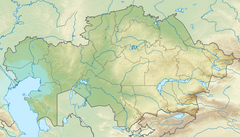Russian observatory
Observatory
Observatory "Kamenskoe Plateau" (Russian: Каменское плато) is an astronomical observatory founded in 1947 at the Fesenkov Astrophysical Institute. In 1948, Gavriil Tikhov headed an independent institution - the astrobotany sector of the Academy of Sciences of the Kazakh SSR - and founded his own observatory. After Tikhov's death in 1960, the astrobotany sector was disbanded. The observatory is located in the grounds of the Fesenkov Institute.
History
Observations of the solar eclipse of September 21, 1941, in Kazakhstan were carried out by seven expeditions, which included astronomers, physicists and geophysicists from Moscow and Leningrad. In light of the Axis invasion of the Soviet Union, it was decided to stay in Kazakhstan and join the evacuated scientists in Alma-Ata. So the team of the Research Institute of Astronomy and Physics was formed, created a few weeks later at the suggestion of Vasily Fesenkov. The building of the institute was built after the war by Japanese prisoners. The first searches for a site for the construction of a large observatory with a good astroclimate began in 1943. In the same year, several scientists studying the city found an ideal place for observation near Almaty - the Stone Plateau, which was 1450 meters above sea level. Agrophysicist Vasily Fesenkov and founder Gavriil Tikhov played the roles of the chief project managers. Assistance to scientists and support was provided by Kanysh Satpayev. Today, the Institute of Astrophysics conducts research in 12 areas of astronomy. Temporary expeditions worked on the Kamensk plateau, in Butakovka and in the vicinity of Talgar. In the second half of 1945, the site (11 km (6.8 mi) from Alma-Ata at an altitude of 1,450 metres (4,760 ft) above sea level) and the project of the observatory were chosen, and in March 1946 a government decree on the construction was adopted. The construction itself on the Kamenskoe plateau began in 1947. Until 1950 the observatory was called "Mountain Astrophysical Observatory", and since 1950 the name "Astrophysical Institute" has become official, now bearing the name of its founder - Academician V.G. Fesenkov. Now the observatory has four telescopes, which are used to observe galaxies, stars, planets and geostationary satellites. The observatory is located on the territory of the institute, located on the Kamenskoye plateau, within the city. Periodically in the literature there is the name "Alma-Ata Observatory", and the bus stop is called "Observatory".[2]
Observatory address
050020, Alma-Ata, Kazakhstan, Observatory, 23.

